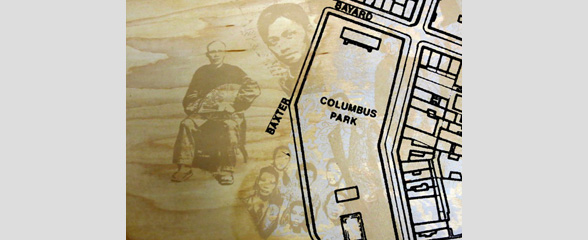 | CAAAV Organizing Asian Communities is a nonprofit community outreach organization dedicated to empowering poor and working class Asian immigrants and refugees in New York City. In this interview, four high school-aged summer interns at CAAAV describe their contributions to a map project that documents the Chinatown landscape. Through excursions in Chinatown, interviews with local residents, and extensive research, these students analyzed the force of gentrifications in New York Lower East Side. Although urban development has made the Lower East Side more safe and attractive, the students express concern for Chinatown long-term and low-income residents who are increasingly priced out of the neighborhood. They go on to consider how the lack of affordable housing and rent-stabilization is threatening Chinatown residents and why it is important to preserve the local community. | 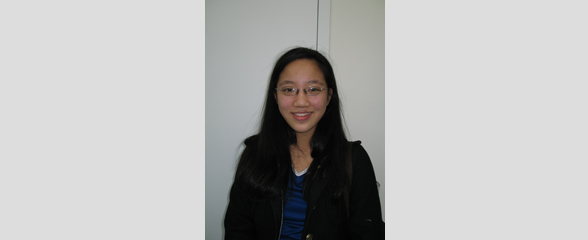 | Jenny Ye was born in Manhattan in 1991, and has been a resident of Chinatown her whole life. She actively volunteers and coordinates for community-oriented organizations such as Chinatown Youth Initiatives, Committee Against Anti-Asian Violence (CAAAV), Chinatown Literacy Project, and Asian Pacific American Youth Alliance (APAYA). Ye first became aware of gentrification at a Chinatown Tenant Union meeting. She visualizes Chinatown as having aged low-rise buildings, fire escapes, no elevators, and inhabited by mostly immigrant families. When asked to define gentrification, she envisions tall buildings, the process of uprooting low-income communities and shifting them elsewhere to give privilege to more affluent residents who are able to afford the renovated real estate. Ye argues that gentrification does not solve issues with safety, crime, sanitation, and poverty because it merely relocates it to another neighborhood. However, she also empathizes with landlords because her parents, who have investments in real estate, rely on gentrification and the ability to raise rent in order to sustain the family’s quality of life. Finally, Ye talks about the changes in Chinatown, claiming that it is now shrinking, and explains that the changes occurred without consideration for the neighborhood’s businesses and residents; in other words, she fears that gentrification will transform Chinatown into “South SoHoâ€. | 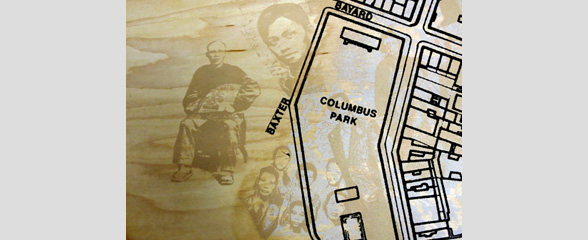 | Born in Chongqing, China and raised in Taiwan, Ching Yeh Chen came to the United States in 1971 to pursue a graduate and masters degree. Chen finally settled in New York and joined her husband operating a retail corporation, Pearl River Market, which was officially founded in 1980. Discussing the history of Pearl River, Chen explains that the corporation had been created to introduce the “real China†to the American society, since as Chen argues there was no significant relationship between the two countries at that time. Some of the challenges the company confronted included government suspicions, increasing rent prices, and an ever-changing customer base. Chen describes Chinatown as being a relatively unsafe environment during the seventies and eighties, which she believes began to change in 1990. She also describes both the rise of the American tourist clientele during the 1990s and the shrinking Chinese garment factory customer base. Finally, she predicts that after a decade, when their lease expires, Pearl River may fade away, as she and her husband will be reaching retirement age and the business will not be handed down to their children. Nonetheless, from her perspective, change is invaluable and Chinatown businesses and residents must be open to the neighborhood evolving – “that’s the challenge, that’s the pressure, that’s the fun.†| 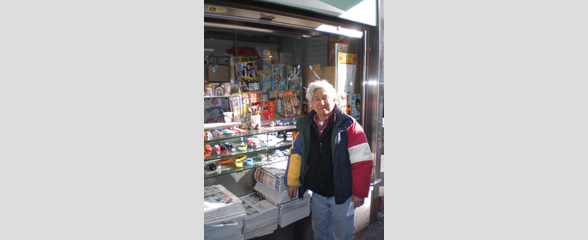 | Francis Tso moved to the United States from Hong Kong in 1976, and settled two year later in Chinatown. For over thirty years, he and his wife have run a newsstand located on Canal Street that was handed down from Tso’s father and leased through the city. Tso portrays Chinatown as a haven for those who do not speak English and, while he says he has seen an increase in business at his stand as a result of development in the area, he also realizes that many non-English speakers are finding it increasingly difficult to stay in Chinatown. They are in an especially hard situation, he says, because their lack of English knowledge prohibits them from moving elsewhere. Over the thirty years that Tso has lived and worked in Chinatown, he has seen many buildings and business dissolved or torn down. As his stand is on Canal Street, he has also witnessed firsthand the increase in the counterfeit market on Canal. Again, Tso sees two sides to the issue. While more customers at the counterfeit stands means more potential customers at his newsstand, he would like to see a community center built in Chinatown that could offer a place for young people to “hang outâ€â€”keeping them away from the counterfeit market. When asked if he might consider retiring, Tso firmly answers that he will continue to operate the stand as long as he is physically able, even though none of his children are interested in running the stand themselves. | 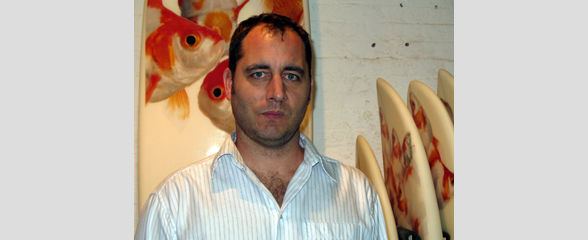 | Dirk Westphal is an Ohio-born artist and currently lives with his family in New York City. Here, he discusses moving to New York in the early 1990s after graduating from college. He eventually settled into a commercial loft-style studio on Centre Street, a locale he identifies as a sort of mixed community of industrious artists and manufacturers. Westphal said that much of his art was a personal reaction to his surroundings, the Chinatown community – his fish photographs, for example, were inspired by the goldfish sold by street vendor shops. Westphal also spoke of his experience as a non-Chinese speaker buying chickens from the Grand Street Poultry Market. Having seen many of the supply stores he regularly frequented in the nineties close, Westphal has turned to the internet instead—it is more efficient, he said, but it also eliminates the element of inspiration through wandering. Westphal also vocalized his opinions of change and the use of the term “gentrification,†saying that while it is often given a negative connotation, he believes that without the “constant renewal and decay that goes on, [New York] wouldn’t be a big, thriving city.†| 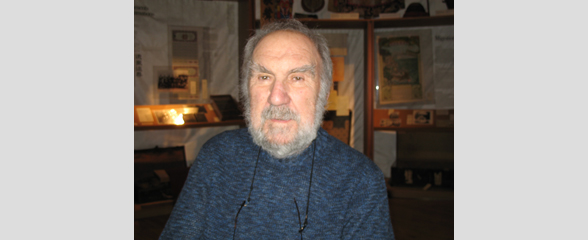 | Bert Feinberg, native to Brooklyn and long-term resident of New York, describes his experiences in Chinatown and the block often referred to as the Daily Forward block, colloquially named after the Yiddish Daily Forward newspaper. There, Feinberg was employed at a family-owned catering and restaurant business called the Garden Cafeteria. During his time at the Cafeteria between 1949 and 1974, he saw significant demographic changes in the neighborhood. Feinberg initially estimates that the Daily Forward block was ninety percent Jewish residents and businesses. By the sixties, and more so the seventies, he observed significant geographic and demographic expansion in Chinatown due to the influx of Chinese immigrants establishing residency and businesses there. Feinberg recalls the unique mixture of customers who frequented the Cafeteria, such as clientele from the Workmens Circle and the Daily Forward, who created a close-knit community within the restaurant. However, as housing became more expensive and long-established businesses relocated or sold their property, the Jewish community gradually dissipated and disappeared. Feinberg ponders whether Chinatown will experience similar changes as the once predominantly inhabited Jewish community, as he has noticed that with increasing gentrification and higher education, younger Chinese generations are choosing professional careers over sustaining family businesses. | 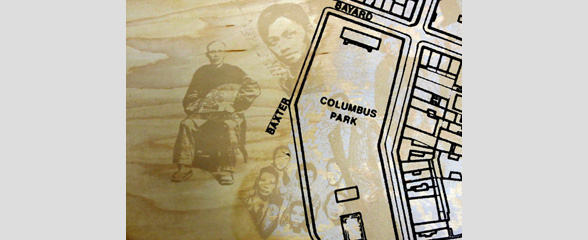 | Fani Jacobson was employed for 53 years at the Daily Forward, a Yiddish newspaper, located in a landmark building near Seward Park. Jacobson was also involved in the socialist organization formerly known as the Workmens Circle (now called Workmens Circle Arbeter Ring). She describes the Lower East Side as a mixed neighborhood comprised of mainly Italian and Jewish sections. She particularly enjoyed the intimate shopping experience and going to the Garden Cafeteria nearly every day for lunch. Jacobson designates 1948 as the neighborhood’s turning point – co-ops were built, Italian residents moved out of the city and onto Long Island, younger generations moved away to avoid living in tenements, and wealthy buyers were able to purchase large pieces of real estate, which were torn down and replaced with luxury buildings. In summary, Jacobson laments the loss of the small town ambience and the disappearance of most of the once-burgeoning Jewish community on the Lower East Side. |  | Betty Sze discusses her vague memory of spending her early childhood playing outside of the Grand Machinery Exchange building, which was located on Centre Street. Her father owned a produce wholesale supply company, while her mother worked in factories. In her interview, she describes gentrification in terms of rent-prices consistently rising, developers becoming more aggressive in planning building projects, and entire neighborhoods such as Little Italy, being taken over by Chinese residents and businesses. Sze characterizes present-day Chinatown as a place that is more attractive to “Westerners†and inviting to tourists. She views tourism as having a positive economic effect on Chinatown, as well as contributing to the vibrancy of the neighborhood, but she also acknowledges that tourism has driven prices up and perhaps detracted from the authenticity of the Chinatown experience. While she has seen many of the special landmarks from her youth disappear from Chinatown, she still considers the neighborhood her spiritual home and an authentic Chinese American experience. | 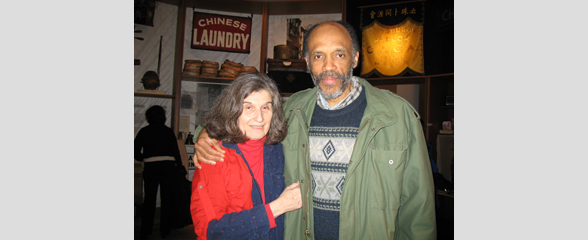 | Husband and wife Daniel Carter and Marilyn Sontag moved together to Chinatown in 1970, where they continue to live and work today—Carter as a musician and writer and Sontag as an abstract artist and part-time gallery coordinator. In their interview, they describe their meeting in Italy and their decision to subsequently relocate to New York City. The couple illustrates Chinatowns community of artists present during the 70s and 80s, and describes the ways in which that atmosphere has changed. Additionally, they explain how they have seen an evolution in SoHo and Little Italy, evident in the increased development and prevalent “boutique culture.†Along these same lines, Carter and Sontag also see a gradual but seemingly constant change in population: as younger, wealthier residents move in, older residents—particularly Asian and Italian residents—are pushed out by higher rent prices. Both would like to see more affordable housing in Chinatown, Little Italy, and SoHo, and Carter expresses a personal struggle with what he perceives as disregard or disrespect for customs and culture in New York, or what he refers to as “brutal displacement.†| 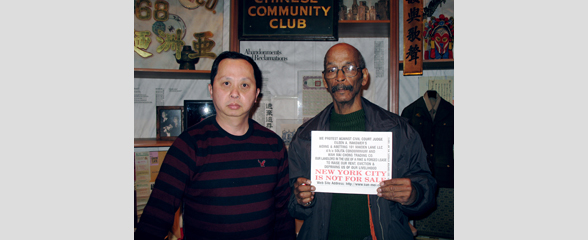 | Mr. Tran emigrated from Vietnam and settled in Brooklyn, New York in 1990, three years after which he opened a family grocery business. Even though he had contracted a five-year lease that was projected to last until 2003, a new landlord took over the building in 1999 at which time Tran received an eviction notice. Ultimately, after seven years of successfully running his grocery business, Tran lost his grocery store—and with it his source of income—over a rent dispute. According to Tran and his attorney, he presented all necessary documentation in court to prove that he was leasing only one property space and had paid his monthly rent in a timely fashion. Unfortunately, Trans initial trial attorney specialized in criminal law not tenant and landlord disputes, and Tran was overruled after his new landlord produced two fraudulent documents which claimed that Tran had agreed to lease two property spaces and was thus deficient in one of the rent payments.
Tran was evicted and lost all of his business property and assets, which were confiscated by the new landlord. He has spent the last seven years fighting the case with little success. During his interview, Tran vocalizes his concerns regarding business closures, informing residents about their rights, and achieving a fair justice system. Tran believes this is a common situation in Chinatown today but that few are willing to fight as he has done.
|









